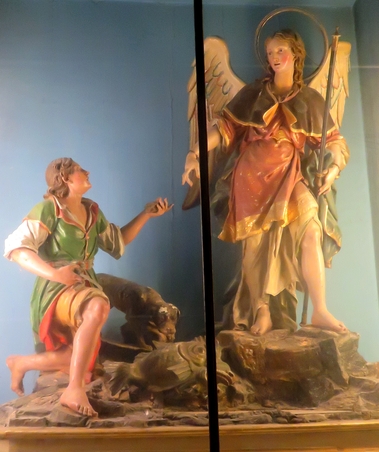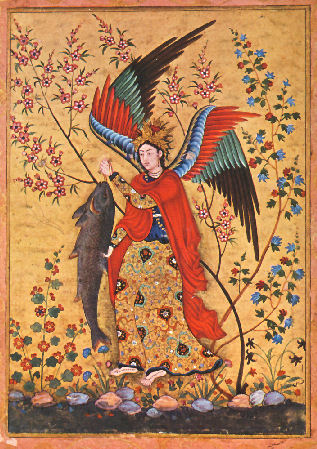The story of Tobit and his son Tobias seems to have been written sometime early in the IInd century BC (the years 199-100) and to have enjoyed great popularity almost immediately. The story is set five or so centuries earlier in the years just after 721 BC, when Israelite leaders have been forcibly moved to Nineveh, in Assyria (modern Mosul, Iraq). It centers on a pious Jew determined to retain his sense of Jewish identity and determined also to practice distinctively Jewish piety even in exile from his beloved homeland.

Life-Sized Altar Statues of Tobias & Raphael (and the Fish and the Dog)
Duomo di Sant'Andrea Apostolo, Amalfi, Italy
Although the text is full of historical references, few of them hang together, and it is hard to see it as having any basis in real history. Rather, it is usually taken as representing a slightly romanticized exile experience that was very real to its IInd century audience and still resonates with readers today. Although classed traditionally among the "historical" works of Hebrew literature, it is perhaps more valuable for its sage advice (reflecting values of the period of its composition) and its implied message about the immanence of God for those who are righteous.
The story was long a favorite subject for European artists, and it continues to be alluded to today in representations of the angel Raphael, who is inevitably portrayed holding a fish or a gourd of water or both. When Tobias is included so is his dog, the only pet dog to appear in Judeo-Christian scriptures.
The story was originally set down in writing, it appears, not in Hebrew, but in Aramaic, a closely related language spoken in Palestine in the last few centuries BC and in Roman times, and it appears to have been very widely known. But a Greek translation, in three different versions, provided the traditional definitive text until in 1955 pieces of the text in both Aramaic and Hebrew turned up among the Dead Sea Scrolls and confirmed the overall accuracy of the long used Greek versions.

The Angel Raphael With Tobias' Fish. India, about 1600
Musée Guimet, Paris
The story is not part of the Jewish or Protestant scriptures, but it is part of the "deuterocanonical" portion of the Old Testament for Roman Catholic and Orthodox Christians. (These books are also referred to as the Old Testament Apocrypha.)
The version provided here is from the copyright-free World English Bible. As is usual in scriptures, individual "verses" are numbered. I have retained the chapter and verse numbering, but have increased the number of paragraph breaks to facilitate on-line reading. I have also added the chapter subtitles. Two review quizzes are linked to the end of the last chapter.
This is the best available copyright-free version. For a different translation, with useful interpretative notes, check the New American Bible text of this work on the web site of the United States Conference of Catholic Bishops. (Link) For a full Hebrew version, from 1885, click here. For the full Greek version, click here or here.)
The various illustrations that decorate these pages are identified in their captions. To the best of my knowledge, all are available for free public educational use.
An audio presentation of an English translation of this work is available on-line. (Link)